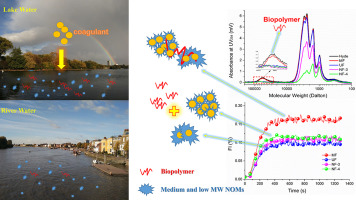当前位置:
X-MOL 学术
›
Water Res.
›
论文详情
Our official English website, www.x-mol.net, welcomes your
feedback! (Note: you will need to create a separate account there.)
Coagulation of surface water: Observations on the significance of biopolymers
Water Research ( IF 11.4 ) Pub Date : 2017-09-13 , DOI: 10.1016/j.watres.2017.09.022 Zhaoyang Su , Ting Liu , Wenzheng Yu , Xing Li , Nigel J.D. Graham
Water Research ( IF 11.4 ) Pub Date : 2017-09-13 , DOI: 10.1016/j.watres.2017.09.022 Zhaoyang Su , Ting Liu , Wenzheng Yu , Xing Li , Nigel J.D. Graham

|
Although the treatment of natural surface waters by coagulation has been investigated extensively, the detailed interaction between natural organic matter and alum is still not adequately understood or predictable, owing to the complexity of different components of the organic matrix and the conditions during coagulation. In this paper, we present the results of a novel approach to the study of the topic, which involved the progressive separation of organic components according to size, followed by coagulation of the filtrate solution, in order to expose the influence of particular organic fractions. Using two natural water sources, representative of lake and river waters, solutions of different organic content were obtained by progressively filtering the source waters using membranes of decreasing pore size; viz. microfiltration (MF), ultrafiltration (UF), and two grades of nanofiltration (NF). While MF had little impact on the range of organics present, UF was able to separate biopolymers (MW > 100 kDa), and NF had a substantially impact on the separation of medium-high MW (1–10 kDa) substances. The results of the coagulation tests showed that the size of flocs was substantially greater when biopolymers were present, suggesting their beneficial role in bridging precipitated Al(OH)3 nanoparticles. For the smaller organic fractions (<10 kDa), the results showed a trend of increasing floc size with decreasing organic MW and concentration, but the trend was minor and may be explained by charge effects. Very similar results were found with both water sources, which support the main finding that biopolymers have an important influence on floc formation.
中文翻译:

地表水的凝结:生物聚合物意义的观察
尽管已经广泛地研究了通过凝结处理天然地表水,但是由于有机基质的不同成分的复杂性和凝结过程中的条件,天然有机物和明矾之间的详细相互作用仍然没有得到充分的理解或可预测。在本文中,我们介绍了一种新颖的方法来研究该主题,其中包括根据大小逐步分离有机成分,然后使滤液浓缩,以暴露特定有机组分的影响。使用两种代表湖泊和河流水的天然水源,通过使用孔径减小的膜对水进行逐步过滤,从而获得了不同有机物含量的溶液。即 微滤(MF),超滤(UF)和两个等级的纳滤(NF)。尽管MF对存在的有机物范围影响不大,但UF能够分离生物聚合物(MW> 100 kDa),而NF对中高MW(1-10 kDa)物质的分离具有实质性影响。混凝试验的结果表明,当存在生物聚合物时,絮凝物的尺寸明显更大,表明它们在桥接沉淀的Al(OH)中的有益作用3个纳米粒子。对于较小的有机部分(<10 kDa),结果显示絮体尺寸随有机分子量和浓度的降低而增加的趋势,但趋势很小,可以用电荷效应来解释。在两种水源中都发现了非常相似的结果,这支持了生物聚合物对絮凝物形成具有重要影响的主要发现。
更新日期:2017-09-14
中文翻译:

地表水的凝结:生物聚合物意义的观察
尽管已经广泛地研究了通过凝结处理天然地表水,但是由于有机基质的不同成分的复杂性和凝结过程中的条件,天然有机物和明矾之间的详细相互作用仍然没有得到充分的理解或可预测。在本文中,我们介绍了一种新颖的方法来研究该主题,其中包括根据大小逐步分离有机成分,然后使滤液浓缩,以暴露特定有机组分的影响。使用两种代表湖泊和河流水的天然水源,通过使用孔径减小的膜对水进行逐步过滤,从而获得了不同有机物含量的溶液。即 微滤(MF),超滤(UF)和两个等级的纳滤(NF)。尽管MF对存在的有机物范围影响不大,但UF能够分离生物聚合物(MW> 100 kDa),而NF对中高MW(1-10 kDa)物质的分离具有实质性影响。混凝试验的结果表明,当存在生物聚合物时,絮凝物的尺寸明显更大,表明它们在桥接沉淀的Al(OH)中的有益作用3个纳米粒子。对于较小的有机部分(<10 kDa),结果显示絮体尺寸随有机分子量和浓度的降低而增加的趋势,但趋势很小,可以用电荷效应来解释。在两种水源中都发现了非常相似的结果,这支持了生物聚合物对絮凝物形成具有重要影响的主要发现。











































 京公网安备 11010802027423号
京公网安备 11010802027423号